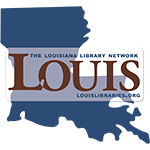American History I
Topic outline
-
Course Introduction
This course will survey American history from its colonial origins to the end of the Civil War in 1865. Students are encouraged to think critically about events, people, and developments covered during the course of the semester. The course is designed to meet the general education goals listed in the catalog. Students will learn how to think critically, research, analyze documents, communicate effectively, and improve their information literacy, all skills that can be applied in a variety of careers.
Upon successful completion of this course, the student will be able to achieve the following Course Level Objectives (hereafter referred to as CO throughout the rest of the course):
- Demonstrate knowledge of important historical events and people in early American history up to 1865;
- Locate, retrieve, and analyze historical data relevant to the peoples, events, movements and institutions covered in the course material and answer questions based on that retrieval;
- Compose essays examining important historical events/topics that are clearly stated, factually precise, and complete in form
- Choose and defend a position about a historical topic on a discussion board.
Navigating the Course
Adopting institution should provide learners information on how to navigate the course. Consider adding an introductory navigation video. Text description could include, for example:This course is set up in Modules covering various topics which may be accessed from the course navigation menu on the left or by scrolling below. Modules may be collapsed in the menu and it the body of the course to minimize scrolling. Each module includes the relevant chapters followed by various activities, which may include discussion forums, listening activities and quizzes, practice quizzes, module tests, and other relevant activities as appropriate for each module. Many items are required and may be marked as completed automatically when the activity has been submitted (the broken check box), but others will marked as done by the student (the solid check box).Please move through the items below and continue through the Learner Support and Getting Started modules before moving on to Module 1. Be sure to check for announcements and due dates to stay on track.
 This course and its contents are licensed under a Creative Commons Attribution 4.0 International License by LOUIS: The Louisiana Library Network, except where otherwise noted.
This course and its contents are licensed under a Creative Commons Attribution 4.0 International License by LOUIS: The Louisiana Library Network, except where otherwise noted. -
Chapter 1: The Americas, Europe, and Africa Before 1492
-
This module contains all the items you should review and complete before you begin Module 1. Before moving on, be sure to:
- Read the Course Syllabus
- Introduce yourself to the class
- Familiarize yourself with the News and Announcements Forum
- Read the instructions for the Q & A Forum
Good luck in the course!-
Use this forum to tell us a little about yourself and your interests. Some topic ideas:
- What is your field of study/research interest or concentration?
- What are you most interested in learning about in this class and why?
- Have you ever taken an online class before?
- Any other information you would like to share with your classmates, such as special interests or activities.
-
Use this forum to ask your instructor any questions you have about the course. You may post at any time, and your instructor will respond here. Be as specific as possible.
Please keep in mind that others can see your posts, so do not post any personal information. If you have questions about your grade, please email your instructor directly. You can expect a response to posts and emails within 24 hours.
-
Use this forum to tell us a little about yourself and your interests. Some topic ideas:
- What is your field of study/research interest or concentration?
- What are you most interested in learning about in this class and why?
- Have you ever taken an online class before?
- Any other information you would like to share with your classmates, such as special interests or activities.
-
Use this forum to ask your instructor any questions you have about the course. You may post at any time, and your instructor will respond here. Be as specific as possible.
Please keep in mind that others can see your posts, so do not post any personal information. If you have questions about your grade, please email your instructor directly. You can expect a response to posts and emails within 24 hours.
-
Use the information in this module to customize the template to your needs. This module is currently hidden from students, and available for you to refer to throughout the semester.
-
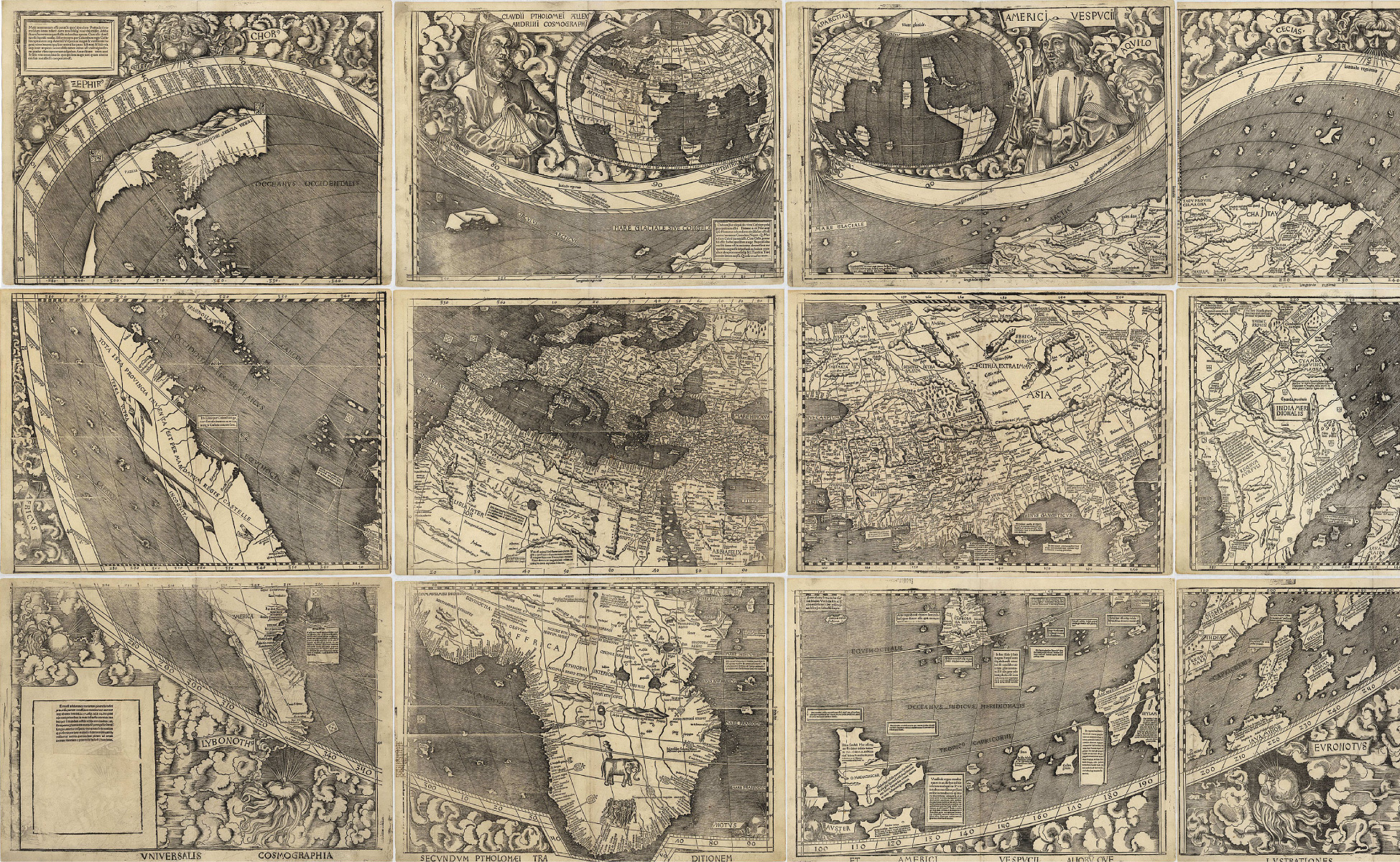 Image from Chapter 1 of U.S. History (opens in new window) from OpenStax, licensed under Creative Commons Attribution License v4.0 with the image information: This 1507 map by cartographers Martin Waldseemüller and Matthais Ringmann is credited as the first to incorporate the word "America." Little was known about the continent at the time, as the land masses on the far left of the map reveal. But the New World offered opportunity that the Old World would exploit.
Image from Chapter 1 of U.S. History (opens in new window) from OpenStax, licensed under Creative Commons Attribution License v4.0 with the image information: This 1507 map by cartographers Martin Waldseemüller and Matthais Ringmann is credited as the first to incorporate the word "America." Little was known about the continent at the time, as the land masses on the far left of the map reveal. But the New World offered opportunity that the Old World would exploit.This week you will be learning about early America and the origins of European Exploration and its consequences. Some highlights include a discussion of the first inhabitants, mistakenly called Indians by the Europeans when they first arrived, the economic and religious reasons for European expansion, and the emergence of the Columbian exchange, which had major implications for Europe, the Americas, and Africa. You will also learn about the start of the Atlantic slave trade. To be an informed American citizen, one must understand the complex origins of the nation. The first chapter does a good job of explaining them.
Upon completion of this module, you will be able to:1. Demonstrate knowledge of some of the major Native American civilizations before the arrival of the Spanish. (CO 1 and 2)
2. Identify key aspects of the European societies that engaged in conversion, conquest, commerce, and exploration (CO 1 and 2)
3. Recognize the important roles of Islam and Europe in West Africa and the slave trade. (CO 1 and 2)
4. (Assignment Only): Analyze a primary source and discuss the reasons for European Exploration. (CO 1, 2, and 3)
To achieve these objectives:
- Read the Module 1 Introduction above.
- Read and view the materials in Chapter 1 (click below)
- View the Chapter 1 PowerPoint below.
- Complete Module 1 quizzes/assignments/discussion boards based on chapter/document reading.
Module Pressbooks Resources and Activities
You will find the following resources and activities in this module at the Pressbooks website. Click on the links below to access or complete each item.
- Read the Module 1 Introduction above.
-
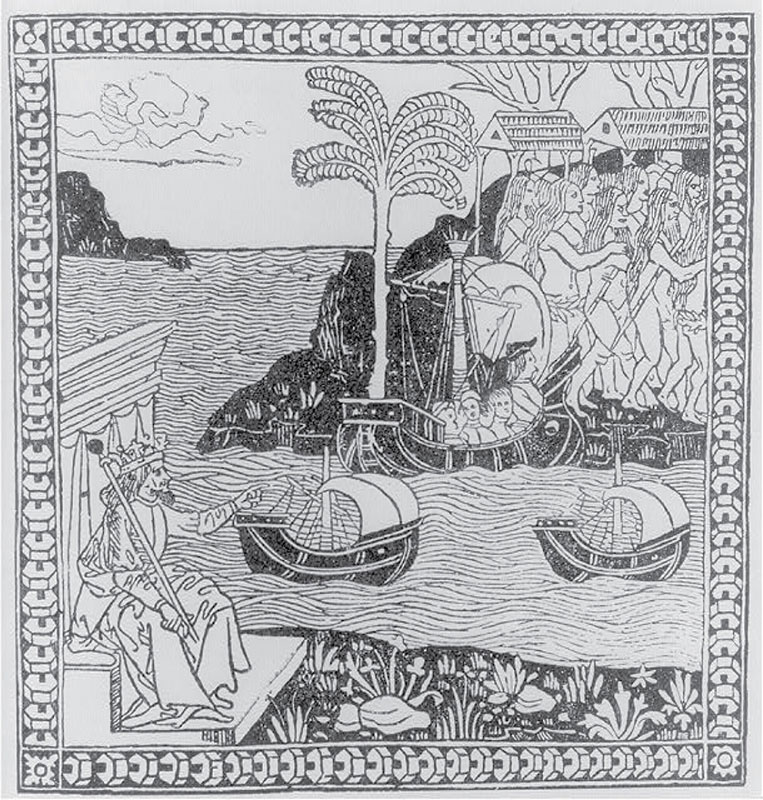 Image from Chapter 2 of U.S. History (opens in new window) from OpenStax, licensed under Creative Commons Attribution License v4.0 with the image information: After Christopher Columbus “discovered” the New World, he sent letters home to Spain describing the wonders he beheld. These letters were quickly circulated throughout Europe and translated into Italian, German, and Latin. This woodcut is from the first Italian verse translation of the letter Columbus sent to the Spanish court after his first voyage, Lettera delle isole novamente trovata by Giuliano Dati.
Image from Chapter 2 of U.S. History (opens in new window) from OpenStax, licensed under Creative Commons Attribution License v4.0 with the image information: After Christopher Columbus “discovered” the New World, he sent letters home to Spain describing the wonders he beheld. These letters were quickly circulated throughout Europe and translated into Italian, German, and Latin. This woodcut is from the first Italian verse translation of the letter Columbus sent to the Spanish court after his first voyage, Lettera delle isole novamente trovata by Giuliano Dati.This week you will be building on the knowledge from last week as you learn about early Portuguese and Spanish exploration, the emergence of the Protestant Reformation and its impact on Europe and the colonization of the Americas, the rise of challengers to Spain's supremacy like England, and the start of forced labor of Native Americans and millions of African slaves. You will also be required to hone your critical thinking skills by discerning the differences between multiple historical sources.
Upon completion of this module, you will be able to:- Recognize the importance of Portuguese and Spanish exploration and the impact on Native Americans. (CO 1 and 2)
- Demonstrate knowledge of the changes brought by the Protestant Reformation and Spain’s response to it. (CO 1 and 2)
- Identify unique aspects of the early English, French, and Dutch colonies. (CO 1 and 2)
- Show an understanding of some of the key aspects of labor and commerce in Europe and the New World. (CO 1 and 2)
- (Assignment Only): Compare and contrast a video presentation of Spanish treatment of the Natives with the textbook's treatment of the same topic. (CO 1 and 2)
To achieve these objectives:
- Read the Module 2 Introduction above
- Read and view the materials in the Chapter 2 Pressbooks book below.
- View the Chapter 2 PowerPoint below
- Complete Module 2 quizzes/assignments/discussion boards based on chapter reading, PowerPoint, and video.
Module Pressbooks Resources and Activities
You will find the following resources and activities in this module at the Pressbooks website. Click on the links below to access or complete each item.
-
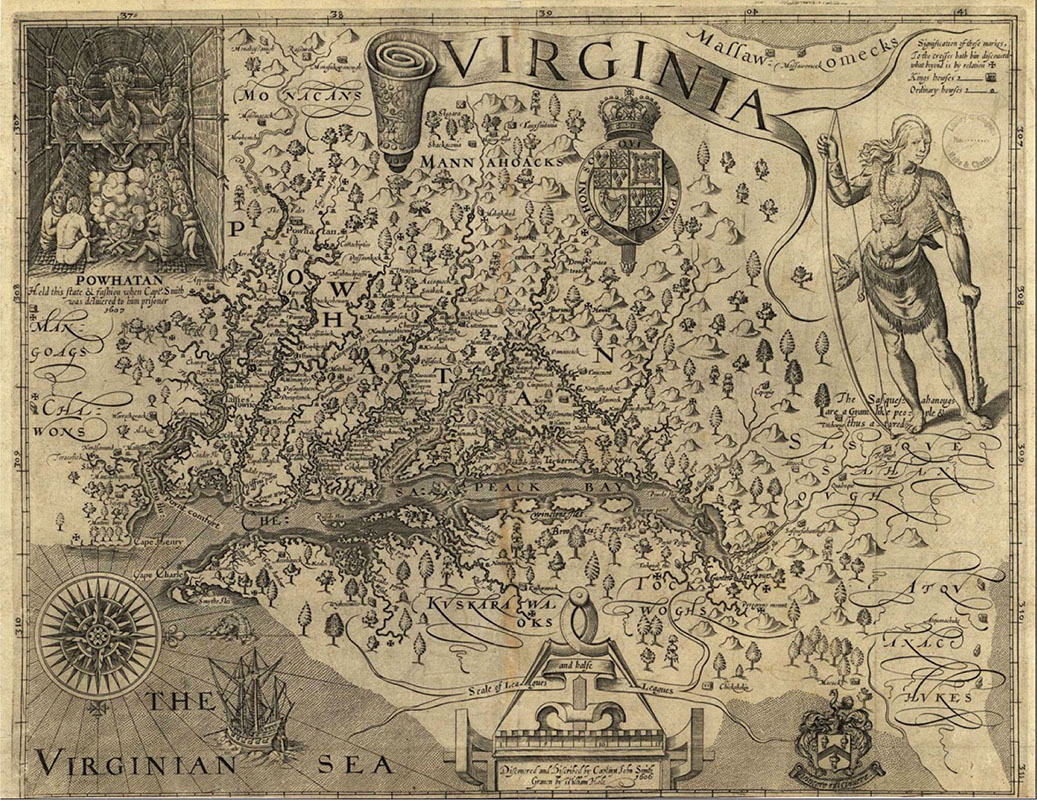 Image from Chapter 3 of U.S. History (opens in new window) from OpenStax, licensed under Creative Commons Attribution License v4.0 with the image information: John Smith’s famous map of Virginia (1622) illustrates many geopolitical features of early colonization. In the upper left, Powhatan, who governed a powerful local confederation of Algonquian communities, sits above other local leaders, denoting his authority. Another native figure, Susquehannock, who appears in the upper right, visually reinforces the message that the English did not control the land beyond a few outposts along the Chesapeake.
Image from Chapter 3 of U.S. History (opens in new window) from OpenStax, licensed under Creative Commons Attribution License v4.0 with the image information: John Smith’s famous map of Virginia (1622) illustrates many geopolitical features of early colonization. In the upper left, Powhatan, who governed a powerful local confederation of Algonquian communities, sits above other local leaders, denoting his authority. Another native figure, Susquehannock, who appears in the upper right, visually reinforces the message that the English did not control the land beyond a few outposts along the Chesapeake.Last week, you learned about early European exploration and colonization especially by the Spanish. This module will explore the expansion of Spanish colonial settlements throughout the Americas, Dutch and English colonial challenges to the Spanish in North America, England's first attempts at settlement in America including Jamestown, the impact of colonization on America. Students will get their first exposure to the earliest permanent English settlements, which eventually became the foundation of the 13 original British colonies and ultimately, the United States of America.
Upon completion of this module, you will be able to:
1. Demonstrate knowledge of the main Spanish American colonial settlements of the 1500s and 1600s. (CO 1 and 2)
2. Identify some of the key aspects of the Dutch and French colonies in North America. (CO 1 and 2)
3. Recall some of the most significant details about the first English settlements in America. (CO 1 and 2)
4. Recognize some of the most important effects of colonization such as the rise of slavery, changes to Indian life, and/or environmental changes.(CO 1 and 2)
5. (ASSIGNMENT ONLY): Discuss some of the problems facing the English as they tried to settle Jamestown based on the reading of a primary source. (CO 1, 2 and 3)To achieve these objectives:
- Read the Module 3 Introduction above
- Read and view the materials in the Chapter 3 Pressbooks book below.
- View the Chapter 3 PowerPoint below
- Complete Module 3 quizzes/assignments/discussion boards based on chapter reading, PowerPoint, and primary source
Module Pressbooks Resources and Activities
You will find the following resources and activities in this module at the Pressbooks website. Click on the links below to access or complete each item.
- Read the Module 3 Introduction above
-
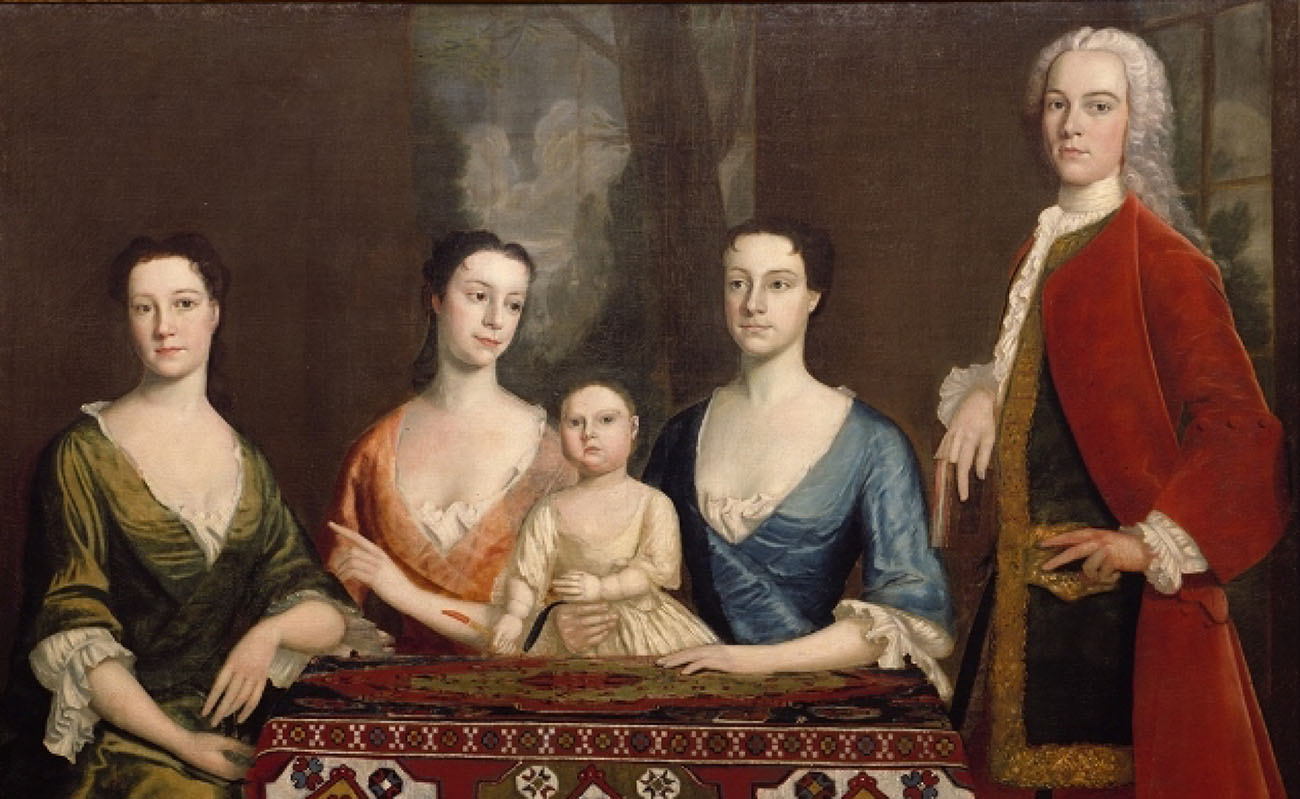 Image from Chapter 4 of U.S. History (opens in new window) from OpenStax, licensed under Creative Commons Attribution License v4.0 with the image information: Isaac Royall and his family, seen here in a 1741 portrait by Robert Feke (modified), moved to Medford, Massachusetts, from the West Indian island of Antigua, bringing enslaved people with them. They were an affluent British colonial family, proud of their success and the success of the British Empire.
Image from Chapter 4 of U.S. History (opens in new window) from OpenStax, licensed under Creative Commons Attribution License v4.0 with the image information: Isaac Royall and his family, seen here in a 1741 portrait by Robert Feke (modified), moved to Medford, Massachusetts, from the West Indian island of Antigua, bringing enslaved people with them. They were an affluent British colonial family, proud of their success and the success of the British Empire.Last module, you learned about the establishment of the Chesapeake Bay and New England colonies. In this module, you will read about the rest of the thirteen original colonies including the Restoration colonies. You will also learn about England's intervention into American trade using the Navigation Acts, the Glorious Revolution's legacy to the concept of liberty, a consumer revolution in the 18th century, a religious revival known as the Great Awakening, and a number of wars for empire that will set the stage for the American Revolution. Students will gain an appreciation of how American history fits into a larger global context.
Upon completion of this module, you will be able to:- Recall some of the causes and/or consequences of the Restoration period (CO 1 and 2).
- Demonstrate knowledge of the causes and/or outcomes of the Glorious Revolution (CO 1 and 2).
- Recognize the impact of slavery and the consumer revolution (CO 1 and 2).
- Identify some of the most important aspects of the Great Awakening and/or the Enlightenment (CO 1 and 2).
- Recall some of the most important facts about the wars for empire (CO 1 and 2)
- (Sources Assignment only) Analyze primary sources from the chapter (CO 1-3).
To achieve these objectives::
- Read the Module 4 Introduction above
- Read and view the materials in the Chapter 4 Pressbooks book below.
- View the Chapter 4 PowerPoint below
- Complete Module 4 quizzes/assignments/discussion boards based on chapter reading and PowerPoint.
Module Pressbooks Resources and Activities
You will find the following resources and activities in this module at the Pressbooks website. Click on the links below to access or complete each item.
-
 Image from Chapter 5 of U.S. History (opens in new window) from OpenStax, licensed under Creative Commons Attribution License v4.0 with the image information: The Bostonians Paying the Excise-man, or Tarring and Feathering (1774), attributed to Philip Dawe (modified), depicts the most publicized tarring and feathering incident of the American Revolution. The victim is John Malcolm, a customs official loyal to the British crown.
Image from Chapter 5 of U.S. History (opens in new window) from OpenStax, licensed under Creative Commons Attribution License v4.0 with the image information: The Bostonians Paying the Excise-man, or Tarring and Feathering (1774), attributed to Philip Dawe (modified), depicts the most publicized tarring and feathering incident of the American Revolution. The victim is John Malcolm, a customs official loyal to the British crown. At the end of the last chapter in Module 4, you learned about some wars for empire that set the stage for the American Revolution, none more important than the Seven Years War, which started as the French and Indian War in America. This week you will learn how that war, in particular, exacerbated Britain's debt problem, which made them devise a number of new acts and taxes that Americans would see as violations of their traditional English liberties. The Stamp Act, Townshend Acts, and Tea act would all be met with colonial boycotts and resistance culminating with the Boston Tea Party and Coercive Acts. In response, the colonists called the First Continental Congress together, which signified a direct challenge to British authority and a major step towards the call for revolution. Students will begin to understand how taxes and representation have always been hot-button issues in American history.
Upon completion of this module, you should be able to:
- Demonstrate knowledge of Great Britain’s North American colonies after the French and Indian War. (CO 1 and 2)
- Identify key aspects of the 1765 Stamp Act and/or colonial responses to it. (CO 1-3)
- Recognize the importance of the 1767 Townshend Acts and/or the resulting colonial protests and their consequences. (CO 1-3)
- Show knowledge of the purposes of and/or reactions to the Tea Act of 1773 and the Coercive Acts. (CO 1 and 2)
- Recall important facts surrounding the calling, proceedings, and consequences of the First Continental Congress. (CO 1 and 2)
- (ASSIGNMENT ONLY): Write an essay on the difference between colonial reaction to the Stamp Act vs. the Sugar Act. (CO 1-3)
To achieve these objectives:
- Read the Module 5 Introduction above
- Read and view the materials in the Chapter 5 Pressbooks book below.
- View the Chapter 5 PowerPoint below
- Complete Module 5 quizzes/assignments/discussion boards based on chapter reading and PowerPoint.
Module Pressbooks Resources and Activities
You will find the following resources and activities in this module at the Pressbooks website. Click on the links below to access or complete each item.
-
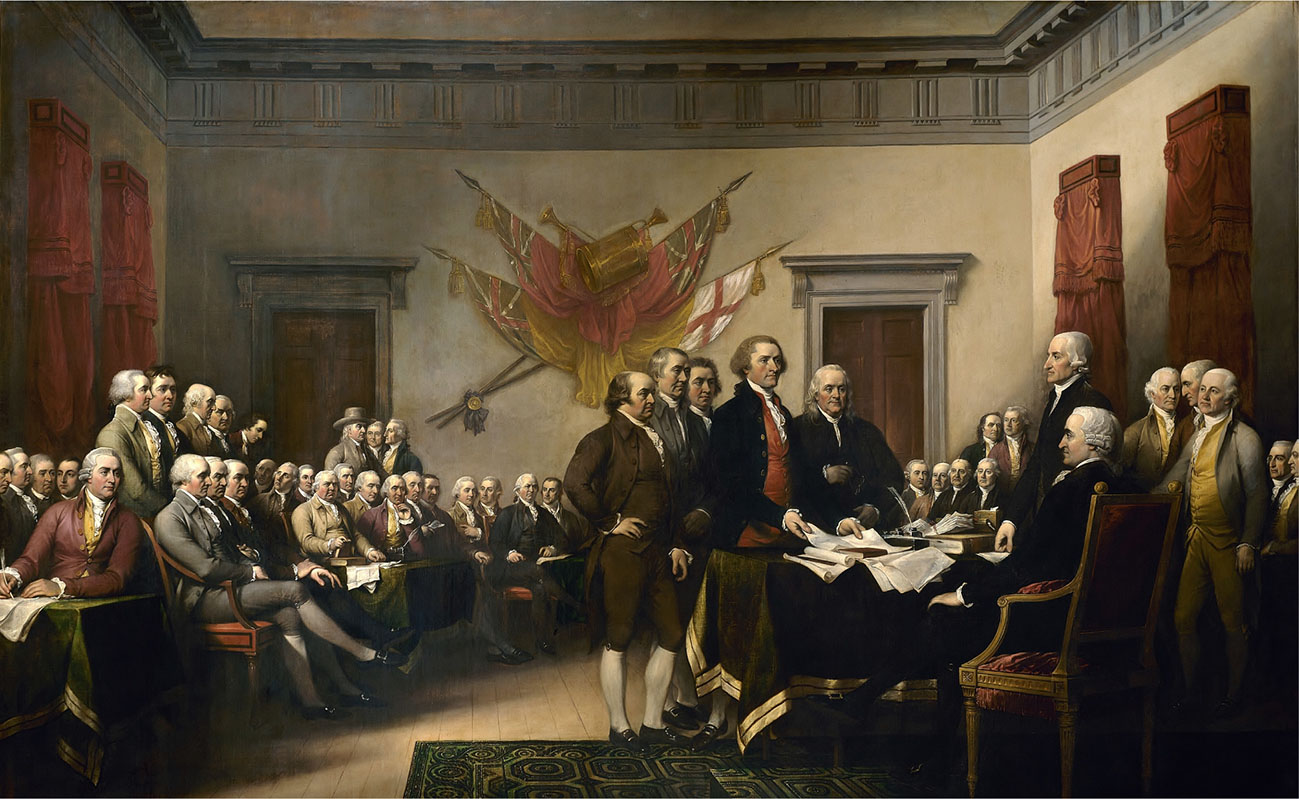 Image from Chapter 6 of U.S. History (opens in new window) from OpenStax, licensed under Creative Commons Attribution License v4.0 with the image information: This famous 1819 painting by John Trumbull shows members of the committee entrusted with drafting the Declaration of Independence presenting their work to the Continental Congress in 1776. Note the British flags on the wall. Separating from the British Empire proved to be very difficult as the colonies and the Empire were linked with strong cultural, historical, and economic bonds forged over several generations.
Image from Chapter 6 of U.S. History (opens in new window) from OpenStax, licensed under Creative Commons Attribution License v4.0 with the image information: This famous 1819 painting by John Trumbull shows members of the committee entrusted with drafting the Declaration of Independence presenting their work to the Continental Congress in 1776. Note the British flags on the wall. Separating from the British Empire proved to be very difficult as the colonies and the Empire were linked with strong cultural, historical, and economic bonds forged over several generations.After the Coercive Acts, which you learned about in the last module, Americans began to see the British as a threat to their fundamental liberties. Colonial militias began to prepare for conflict, and they would engage in the first real shooting of the American Revolution in Lexington and Concord, which will be discussed in the reading for this week. You will also learn about the Declaration of Independence and its historical significance, the course of the American Revolution including some of the more important battles like Saratoga, the vital role of France's aid to the Americans, and the role of loyalists and patriots throughout the American Revolution.
Upon completion of this module, you will be able to:- Demonstrate knowledge of the events/facts surrounding the beginning stages of the American Revolution. (CO 1 and 2)
- Identify some aspects of the British and American strategies and/or the key battles from 1776 through 1778. (CO 1 and 2)
- Recall important factors which led to the British southern strategy and/or the end of the Revolution and key facts about the Treaty of Paris. (CO 1 and 2)
- Recognize important details about the different groups (Loyalists and Patriots) who participated in the Revolutionary War. (CO 1 and 2)
- (ASSIGNMENT ONLY): Locate and retrieve a primary source (the Declaration of Independence). (CO 1-3)
- (ASSIGNMENT ONLY): Analyze, discuss, and explain parts of the Declaration of Independence. (CO 1-3)
To achieve these objectives:
- Read the Module 6 Introduction above.
- Read and view the materials in the Chapter 6 Pressbooks book below.
- View Chapter 6 PowerPoint below.
- Complete Module 6 quizzes/assignments/discussion boards based on chapter and primary source reading.
Module Pressbooks Resources and Activities
You will find the following resources and activities in this module at the Pressbooks website. Click on the links below to access or complete each item.
-
 Image from Chapter 7 of U.S. History (opens in new window) from OpenStax, licensed under Creative Commons Attribution License v4.0 with the image information: Figure 7.1 John Trumbull, Washington’s aide-de-camp, painted this wartime image of Washington on a promontory above the Hudson River. Just behind Washington, enslaved William “Billy” Lee has his eyes firmly fixed on his slaveholder. In the far background, British warships fire on an American fort.
Image from Chapter 7 of U.S. History (opens in new window) from OpenStax, licensed under Creative Commons Attribution License v4.0 with the image information: Figure 7.1 John Trumbull, Washington’s aide-de-camp, painted this wartime image of Washington on a promontory above the Hudson River. Just behind Washington, enslaved William “Billy” Lee has his eyes firmly fixed on his slaveholder. In the far background, British warships fire on an American fort.Module 6 covered how the United States won its independence from Great Britain, which was an unprecedented and astounding achievement in its own right. This week, you will be learning about something that is perhaps an even more impressive achievement, namely, the establishment of a stable and long-lived representative government. As you will learn, it was not easy, but in the end, the founders made enough compromises to put a new Constitution in place that proved to be a good start but also contained many flaws that would need correction through the amendment process over the next two centuries. Some highlights of the chapter include debates about the merits of different types of governments and the status of nonwhites and women in the new nation, the need for something beyond the Articles of Confederation, and the major decisions made at the Constitutional Convention. This week, students will also be required to think critically and engage respectfully with classmates on a discussion board.
Upon completion of this module, you will be able to:
- Demonstrate knowledge of the concepts of republicanism and monarchy. (CO 1 and 2)
- Recognize the unique status of women and nonwhites in the new republic. (CO 1 and 2)
- Recall important facts about the Articles of Confederation.(CO 1 and 2)
- Identify some of the causes and/or consequences of Shay’s Rebellion. (CO 1 and 2)
- Show knowledge of the issues and/or solutions of the 1787 Constitutional Convention.(CO 1 and 2)
- Choose and defend a position about the adoption of the Constitution on a discussion board. (CO 1-4)
To achieve these objectives:
- Read the Module 7 Introduction above.
- Read and view the materials in the Chapter 7 Pressbooks book below.
- View Chapter 7 PowerPoint below.
- Complete Module 7 quizzes/assignments/discussion boards based on chapter reading.
Module Pressbooks Resources and Activities
You will find the following resources and activities in this module at the Pressbooks website. Click on the links below to access or complete each item.
-
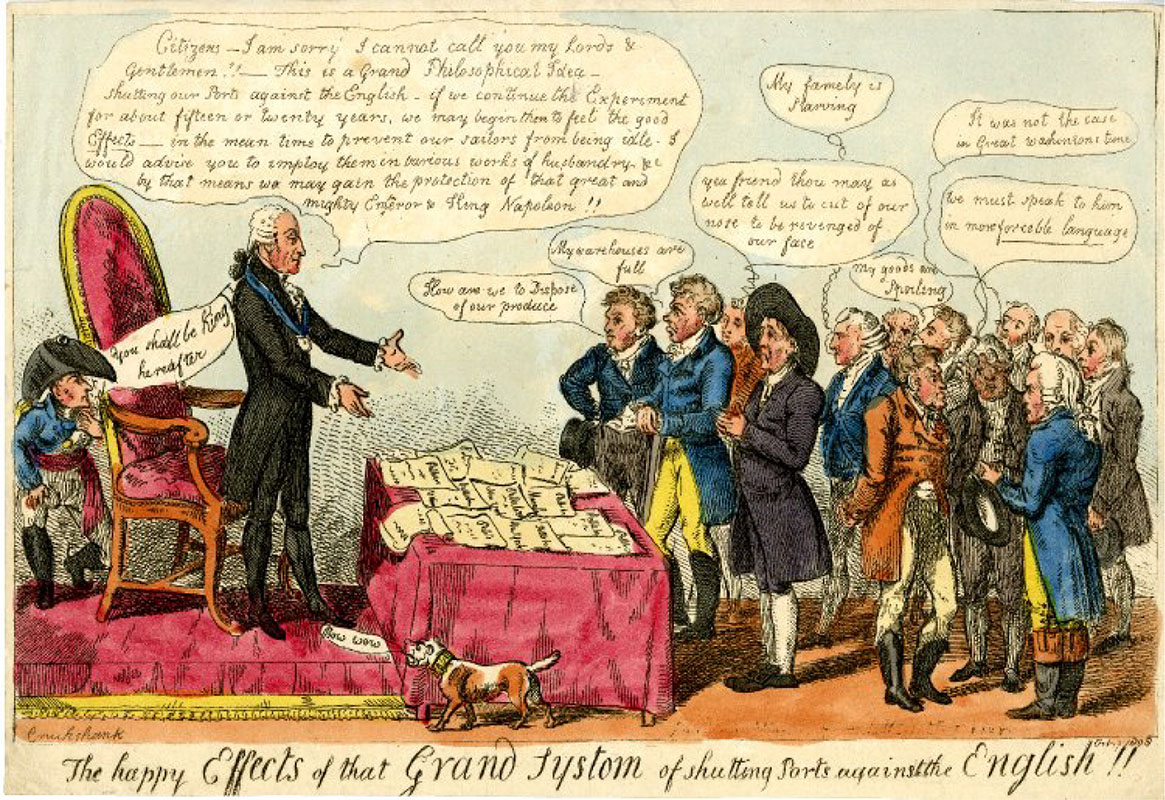 Image from Chapter 23 of U.S. History [Link opens in new window] from OpenStax, licensed under Creative Commons Attribution License v4.0 with the image information: “The happy Effects of the Grand Systom [sic] of shutting Ports against the English!!” appeared in 1808. Less than a year earlier, Thomas Jefferson had recommended (and Congress had passed) the Embargo Act of 1807, which barred American ships from leaving their ports.
Image from Chapter 23 of U.S. History [Link opens in new window] from OpenStax, licensed under Creative Commons Attribution License v4.0 with the image information: “The happy Effects of the Grand Systom [sic] of shutting Ports against the English!!” appeared in 1808. Less than a year earlier, Thomas Jefferson had recommended (and Congress had passed) the Embargo Act of 1807, which barred American ships from leaving their ports.In the last module, you learned about how the United States got its Constitution and established a stable representative government. In this module, you will learn about the emergence of some significant challenges to that new government including a number of domestic and foreign policy crises in the 1790s, the start of a divisive two party system in the nation, and a second war with Great Britain, the War of 1812. Students will gain an understanding of how the nation was able to meet these challenges and not only survive but thrive.
Upon completion of this module, you will be able to:- Identify some of the main ideas of the Federalists and the Democratic-Republicans. (CO 1 and 2)
- Demonstrate knowledge of the Bill of Rights and/or Alexander Hamilton’s financial programs. (CO 1 and 2)
- Recall facts about the major foreign and domestic uprisings of the early 1790s. (CO 1 and 2)
- Show awareness of the partisan differences between the Federalists and Democratic-Republicans and the effects of foreign relations on American politics. (CO 1 and 2)
- Recognize the significance of the Louisiana Purchase. (CO 1 and 2)
- Demonstrate knowledge of some of the causes and/or important events and/or consequences of the War of 1812. (CO 1 and 2)
To achieve these objectives:
- Read the Module 8 Introduction above.
- Read and view the materials in the Chapter 8 Pressbooks book below.
- View Chapter 8 PowerPoint below.
- Complete Module 8 quizzes/assignments/discussion boards based on chapter and reading and video.
Module Pressbooks Resources and Activities
You will find the following resources and activities in this module at the Pressbooks website. Click on the links below to access or complete each item.
-
In this module you will take your midterm exam. Read the instructions carefully and take note of any special submission guidelines.
Upon completion of this module, you will have:
- Read and viewed the midterm exam instructions
- Scheduled your exam with the proctoring service (If necessary)
- Prepared for and submitted your midterm exam
To achieve these objectives:
- Read and view the contents of "Exam Information and Instructions"
- Log in to the proctoring service (if necessary) and take your exam.
-
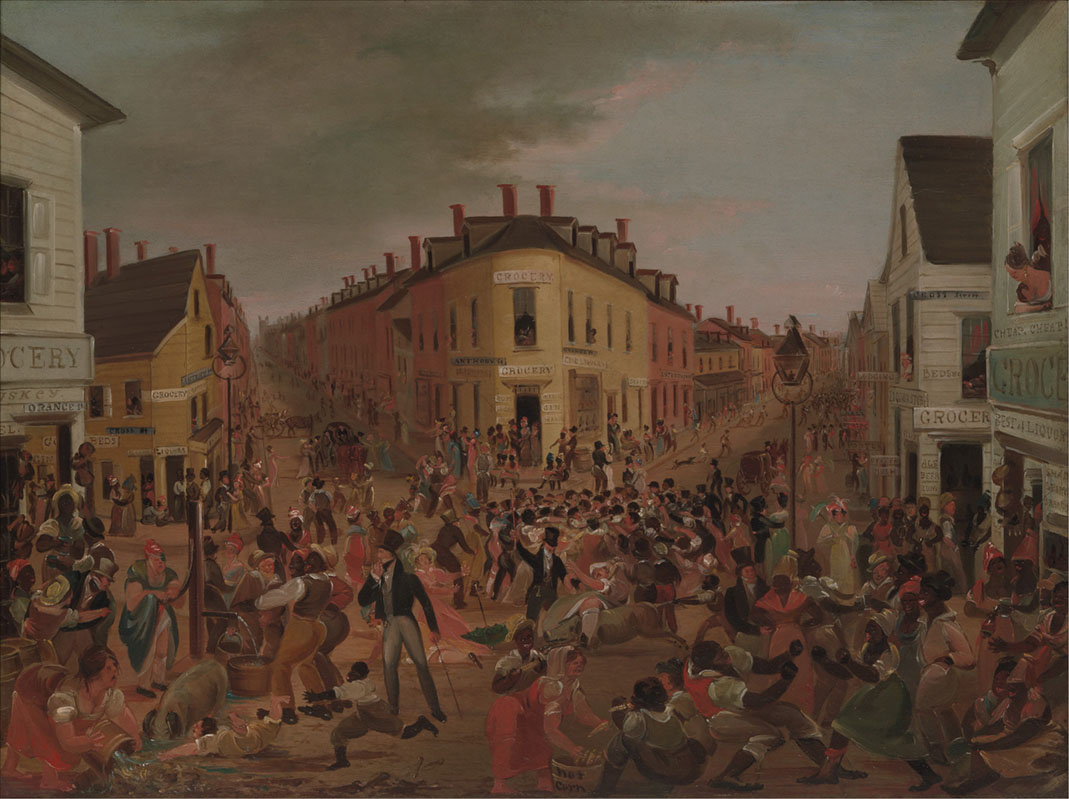 Image from Chapter 9 of U.S. History (opens in new window) from OpenStax, licensed under Creative Commons Attribution License v4.0 with the image information: Five Points (1827), by George Catlin, depicts the infamous Five Points neighborhood of New York City, so called because it was centered at the intersection of five streets. Five Points was home to a polyglot mix of recent immigrants, formerly enslaved people, and other members of the working class.
Image from Chapter 9 of U.S. History (opens in new window) from OpenStax, licensed under Creative Commons Attribution License v4.0 with the image information: Five Points (1827), by George Catlin, depicts the infamous Five Points neighborhood of New York City, so called because it was centered at the intersection of five streets. Five Points was home to a polyglot mix of recent immigrants, formerly enslaved people, and other members of the working class.In this module, you will learn about how the industrial and market revolutions in the early 19th century, combined with advances in transportation, reshaped the economic and social landscape of the United States. Americans could now more than ever quickly produce larger amounts of goods for a nationwide market as more and more people moved west. As the American economy changed, new class divisions emerged and solidified, resulting in previously unknown economic and social inequalities. Students will gain an understanding of how the nation was able to meet the challenges of industrialization and expansion.
Upon completion of this module, you will be able to:- Demonstrate knowledge of industrialization in the United States and the history of workers’ organizations. (CO 1 and 2)
- Recognize key facts in the process of selling western land, the Panic of 1819, and/or information about key American innovators and inventors. (CO 1 and 2)
- Recall important information about the development of improved methods of nineteenth-century domestic transportation. (CO 1 and 2)
- Identify some of the perceptions and/or ideals of various social classes in America from 1800-1850. (CO 1 and 2)
- (ASSIGNMENT ONLY): Compose an essay examining the similarities and differences between the various social classes in America from 1800-1850. (CO 1-3)
To achieve these objectives:
- Read the Module 9 Introduction above
- Read and view the materials in the Chapter 9 Pressbooks book below.
- View the Chapter 9 PowerPoint below
- Complete Module 9 quizzes/assignments/discussion boards based on chapter reading and PowerPoint.
Module Pressbooks Resources and Activities
You will find the following resources and activities in this module at the Pressbooks website. Click on the links below to access or complete each item.
-
 Image from Chapter 10 of U.S. History (opens in new window) from OpenStax, licensed under Creative Commons Attribution License v4.0 with the image information: In President’s Levee, or all Creation going to the White House, Washington (1841), by Robert Cruikshank, the artist depicts Andrew Jackson’s inauguration in 1829, with crowds surging into the White House to join the celebrations. Rowdy revelers destroyed many White House furnishings in their merriment. A new political era of democracy had begun, one characterized by the rule of the majority.
Image from Chapter 10 of U.S. History (opens in new window) from OpenStax, licensed under Creative Commons Attribution License v4.0 with the image information: In President’s Levee, or all Creation going to the White House, Washington (1841), by Robert Cruikshank, the artist depicts Andrew Jackson’s inauguration in 1829, with crowds surging into the White House to join the celebrations. Rowdy revelers destroyed many White House furnishings in their merriment. A new political era of democracy had begun, one characterized by the rule of the majority.This module introduces the development of democratic ideals during the presidency of Andrew Jackson. Indian removal, nullification crisis, and Bank War infused the institution of the presidency with new power under Andrew Jackson. The rise of the second national political party system, expansion of democratic political rights to white males, the limited meaning of Jacksonian democracy for Native Americans, women, and African Americans, the growing debate over the issue of slavery, and the rise of the Whig party during the 1840 election forever changed the political, social, and economical landscape of America.
Upon completion of this module, you will be able to:- Demonstrate knowledge of American history during the administrations of Andrew Jackson and Martin Van Buren. (CO 1 and 2)
- Describe the political philosophy of Andrew Jackson and how it was reflected in the policies and actions of his administration. (CO 1 and 2, )
- Explain who benefited from Jacksonian democracy, and who suffered. (CO 1 and 2)
- Describe how Andrew Jackson changed the office of the presidency. (CO 1 and 2)
- Identify the supporters and opponents of the Bank of the United States; and explain which side you think was right.(CO 1 and 2)
- Explain the evolution and impact of white attitudes toward Native Americans. (CO 1 and 2, and 3)
To achieve these objectives:
- Read the Module 10 Introduction above.
- Read and view the materials in the Module 10 Pressbooks book below
- View the Chapter 10 PowerPoint below
- Complete Module 10 quizzes/assignments/discussion boards based on chapter reading and PowerPoint.
Module Pressbooks Resources and Activities
You will find the following resources and activities in this module at the Pressbooks website. Click on the links below to access or complete each item.
-
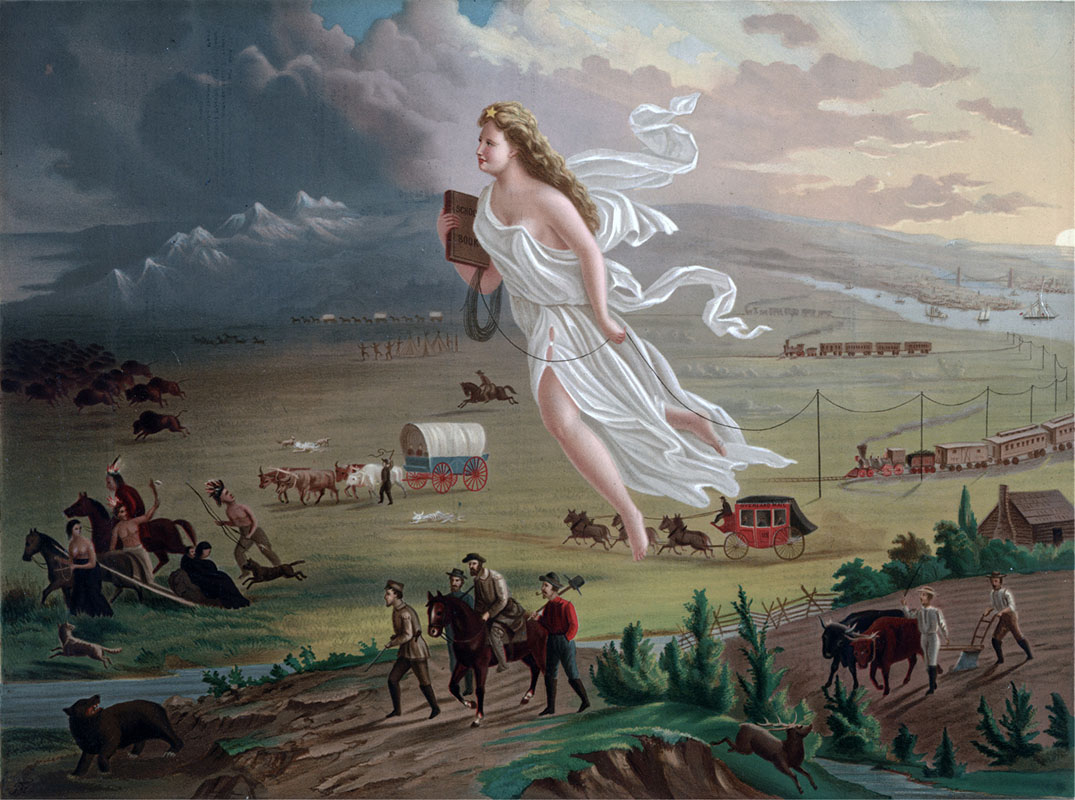 Image from Chapter 11 of U.S. History (opens in new window) from OpenStax, licensed under Creative Commons Attribution License v4.0 with the image information: In the first half of the nineteenth century, settlers began to move west of the Mississippi River in large numbers. In John Gast’s American Progress (ca. 1872), the figure of Columbia, representing the United States and the spirit of democracy, makes her way westward, literally bringing light to the darkness as she advances.
Image from Chapter 11 of U.S. History (opens in new window) from OpenStax, licensed under Creative Commons Attribution License v4.0 with the image information: In the first half of the nineteenth century, settlers began to move west of the Mississippi River in large numbers. In John Gast’s American Progress (ca. 1872), the figure of Columbia, representing the United States and the spirit of democracy, makes her way westward, literally bringing light to the darkness as she advances.This module introduces students to American westward expansion during the first half of the nineteenth century focusing on the Louisiana Purchase and the demographic pressures in the East that led to western migration and the philosophy of Manifest Destiny and its impact on westward expansion, the treatment of Native Americans and Hispanics by American settlers, and the acquisition of Texas and the Southwest from Mexico. The acquisition of new territories and the need for the Compromise of 1850 further showcased the deep divide over the issue of slavery. Students will begin to understand the diverse landscape of America and its lasting impact.
Upon completion of this module, you will be able to:- Recall facts about American westward expansion from 1800-1860. (CO 1 and 2)
- Explain the impact of the Louisiana Purchase (CO 1 and 2)
- Explain how the idea of Manifest Destiny influenced America and Americans during this period (CO 1 and 2)
- Explain how the expansion of slavery deepened divisions between the North and the South (CO 1 and 2)
- Identify the causes and outcomes of the Mexican-American War (CO 1 and 2)
- Describe the terms of the Compromise of 1850 (CO 1 and 2)
To achieve these objectives:
- Read the Module 11 Introduction
- Read and view the materials in the Module 11 Pressbooks book
- Read Chapter 11 PowerPoint
- Complete Module 11 quizzes/assignments/discussion boards based on chapter reading and PowerPoint.
Module Pressbooks Resources and Activities
You will find the following resources and activities in this module at the Pressbooks website. Click on the links below to access or complete each item.
-
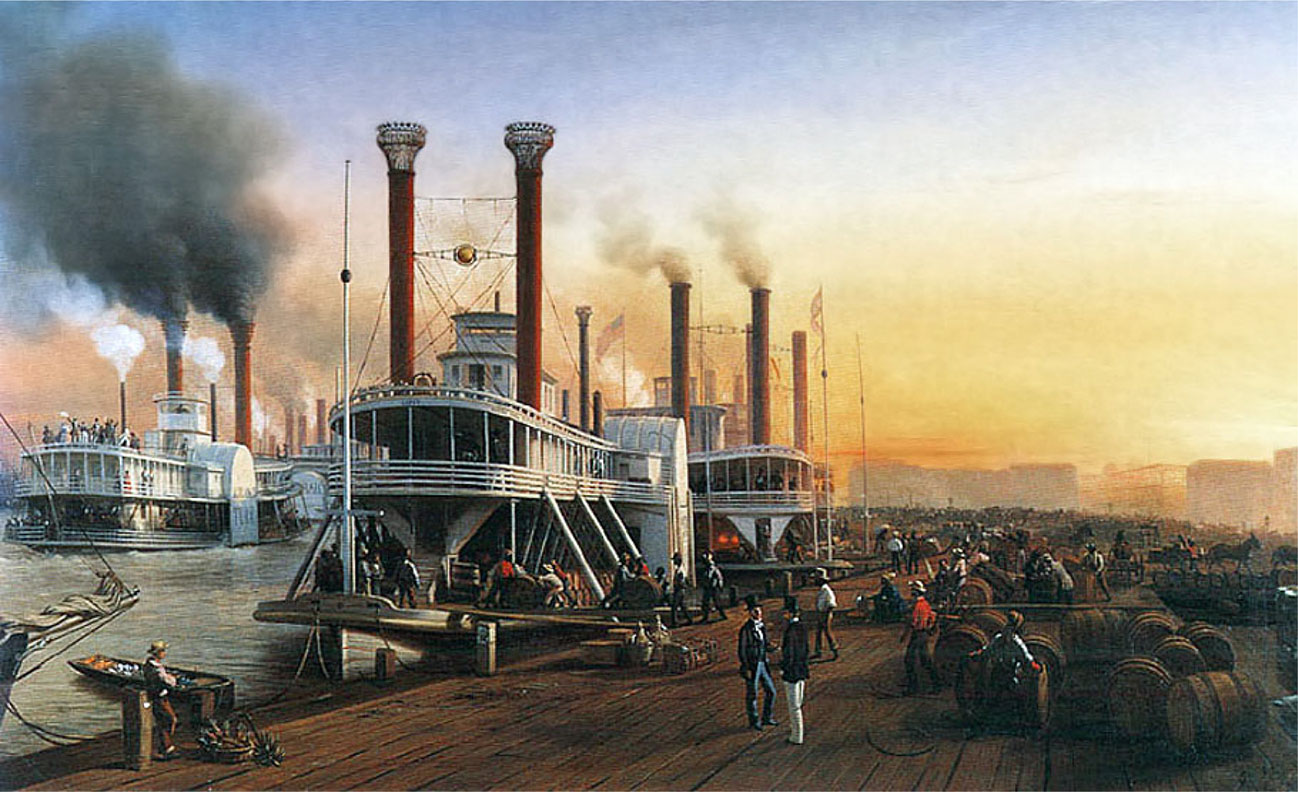 Image from Chapter 12 of U.S. History (opens in new window) from OpenStax, licensed under Creative Commons Attribution License v4.0 with the image information: Bateaux à Vapeur Géant, la Nouvelle-Orléans 1853 (Giant Steamboats at New Orleans, 1853), by Hippolyte Sebron, shows how New Orleans, at the mouth of the Mississippi River, was the primary trading hub for the cotton that fueled the growth of the southern economy.
Image from Chapter 12 of U.S. History (opens in new window) from OpenStax, licensed under Creative Commons Attribution License v4.0 with the image information: Bateaux à Vapeur Géant, la Nouvelle-Orléans 1853 (Giant Steamboats at New Orleans, 1853), by Hippolyte Sebron, shows how New Orleans, at the mouth of the Mississippi River, was the primary trading hub for the cotton that fueled the growth of the southern economy.Module 11 focused on westward expansion. This module explores the centrality of cotton to the American economy in the antebellum period, the specific components of slave life, how slavery shaped the cultural and social life of the south, proslavery southern arguments, many of which were based on racist ideology, and the desperate desire to expand slavery by using methods like the filibuster expeditions. Students will begin to understand just how much slavery was starting to dominate all aspects of American life during the antebellum period.
Upon completion of this module, you will be able to:- Identify important aspects of cotton production and/or the importance of cotton to the Atlantic and American antebellum economy. (CO 1 and 2)
- Demonstrate knowledge of the lives of slaves and free blacks. (CO 1 and 2)
- Recall facts about the code of honor in the antebellum South and some of the key components of the proslavery arguments in the antebellum period. (CO 1 and 2)
- Recognize some of the goals of slavery advocates and key facts about the filibuster expeditions undertaken during the antebellum era. (CO 1 and 2)
- (Assignment Only): Write an essay about the filibuster. (CO 1-3)
To achieve these objectives:
- Read the Module 12 Introduction above.
- Read and view the materials in the Chapter 12 Pressbooks book below.
- View Chapter 12 PowerPoint below.
- Complete Module 12 quizzes/assignments/discussion boards based on chapter reading and PowerPoint.
Module Pressbooks Resources and Activities
You will find the following resources and activities in this module at the Pressbooks website. Click on the links below to access or complete each item.
-
 Image from Chapter 13 of U.S. History (opens in new window) from OpenStax, licensed under Creative Commons Attribution License v4.0 with the image information: The masthead of The Liberator, by Hammatt Billings in 1850, highlights the religious aspect of antislavery crusades. The Liberator was an abolitionist newspaper published by William Lloyd Garrison, one of the leaders of the abolitionist movement in the United States.
Image from Chapter 13 of U.S. History (opens in new window) from OpenStax, licensed under Creative Commons Attribution License v4.0 with the image information: The masthead of The Liberator, by Hammatt Billings in 1850, highlights the religious aspect of antislavery crusades. The Liberator was an abolitionist newspaper published by William Lloyd Garrison, one of the leaders of the abolitionist movement in the United States.In the last module, you learned how slavery was intricately connected to most economic, political, social, and cultural developments in the antebellum south. In this module, you will study a number of reform movements that emerged during those same years. Most of these reform movements expressed idealism and optimism that serious problems could be fixed in America. A Second Great Awakening, communal experiments including attempts at socialism, different approaches to slavery like colonization and abolition, and an early attempt at a women's rights movement make up some of the more important parts of the chapter.
Upon completion of this module, you will be able to:- Recognize the connection between evangelical Protestantism and the Second Great Awakening and the message of the transcendentalists. (CO 1 and 2)
- Demonstrate knowledge of the utopian groups of the antebellum era. (CO 1 and 2)
- Identify some of the developments in health reforms during the antebellum period and some of the key facts about the temperance movement. (CO 1 and 2)
- Show knowledge of the historical efforts to reform the institution of slavery and/or the abolitionist movement in the early to mid-nineteenth century. (CO 1 and 2)
- Recognize the connections between abolition, reform, and antebellum feminism. (CO 1 and 2)
- (Assignment Only): Write a short essay discussing the early women's movement. (CO 1-3)
To achieve these objectives:
- Read the Module 13 Introduction above.
- Read and view the materials in the Module 13 Pressbooks book below
- View the Chapter 13 PowerPoint below
- Complete Module 13 quizzes/assignments/discussion boards based on chapter reading and PowerPoint.
Module Pressbooks Resources and Activities
You will find the following resources and activities in this module at the Pressbooks website. Click on the links below to access or complete each item.
-
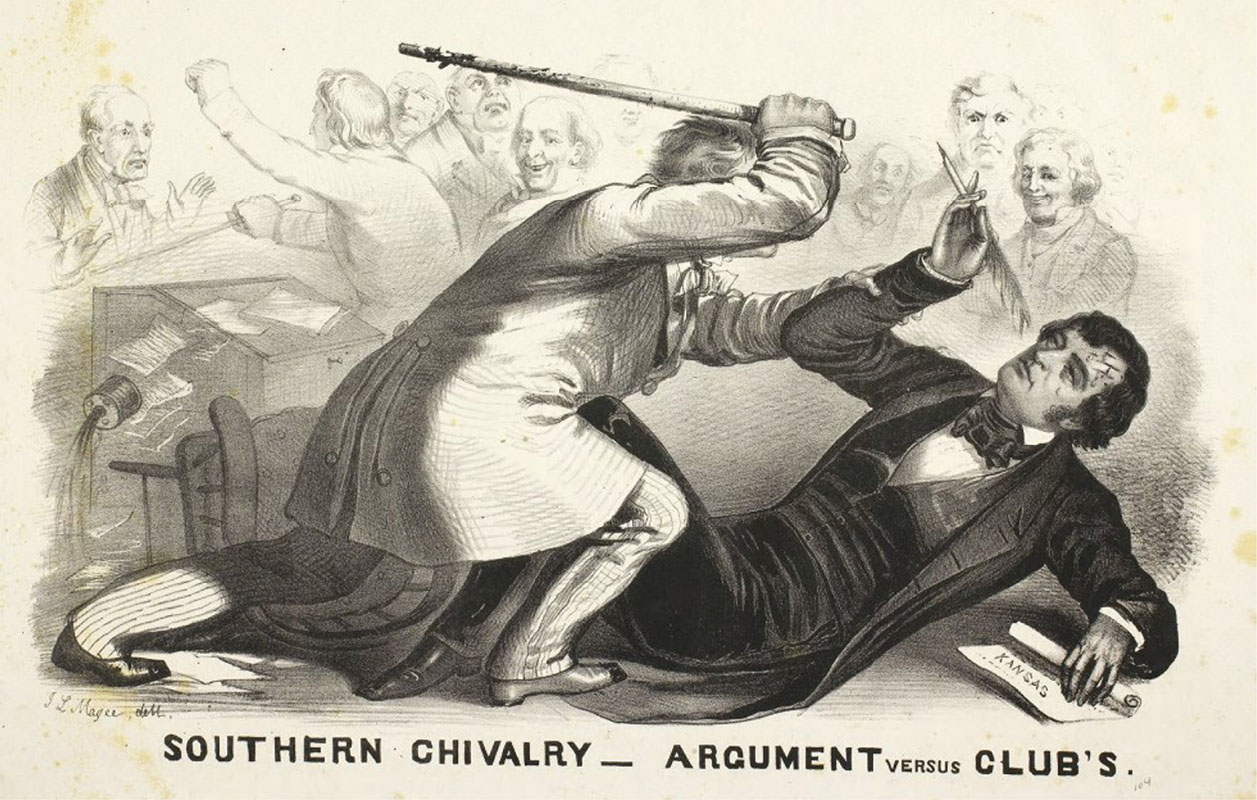 Image from Chapter 31 of U.S. History (opens in new window) from OpenStax, licensed under Creative Commons Attribution License v4.0 with the image information: In Southern Chivalry: Argument versus Club’s (1856), by John Magee, South Carolinian Preston Brooks attacks Massachusetts senator Charles Sumner after his speech denouncing “border ruffians” pouring into Kansas from Missouri. For southerners, defending slavery meant defending southern honor.
Image from Chapter 31 of U.S. History (opens in new window) from OpenStax, licensed under Creative Commons Attribution License v4.0 with the image information: In Southern Chivalry: Argument versus Club’s (1856), by John Magee, South Carolinian Preston Brooks attacks Massachusetts senator Charles Sumner after his speech denouncing “border ruffians” pouring into Kansas from Missouri. For southerners, defending slavery meant defending southern honor.Module 13 covered some important idealistic reform movements that aimed to improve the lives of Americans during the antebellum years. Unfortunately, American lives were about to get much worse during the 1850s, which this module will explore. Divisive legislation like the Compromise of 1850 and the Kansas Nebraska Act, Supreme Court decisions like the one made in a case involving a slave named Dred Scott, and radical and sometimes violent acts over slavery committed by extremists like John Brown all fast-tracked the nation to the start of the Civil War. This module covers those factors (and more), in depth. It will help students understand how Americans got to the point of taking up arms against each other in 1861.
Upon completion of this module, you will be able to:- Demonstrate knowledge of the Compromise of 1850 and the Fugitive Slave Act. (CO 1 and 2)
- Recognize key facts about the Kansas-Nebraska Act and the Republican Party of the 1850s. (CO 1 and 2)
- Identify the importance of the Supreme Court’s Dred Scott decision. (CO 1 and 2)
- Show knowledge of John Brown’s raid on Harpers Ferry and/or the election of 1860. (CO 1 and 2)
- (Assignment Only): Choose and defend a position about John Brown on a discussion board backed up with evidence from your textbook. (CO 1, 2, and 4)
To achieve these objectives:
- Read the Module 14 Introduction above.
- Read and view the materials in the Chapter 14 Pressbooks book below.
- View Chapter 14 PowerPoint below.
- Complete Module 14 quizzes/assignments/discussion boards based on chapter reading and PowerPoint.
Module Pressbooks Resources and Activities
You will find the following resources and activities in this module at the Pressbooks website. Click on the links below to access or complete each item.
-
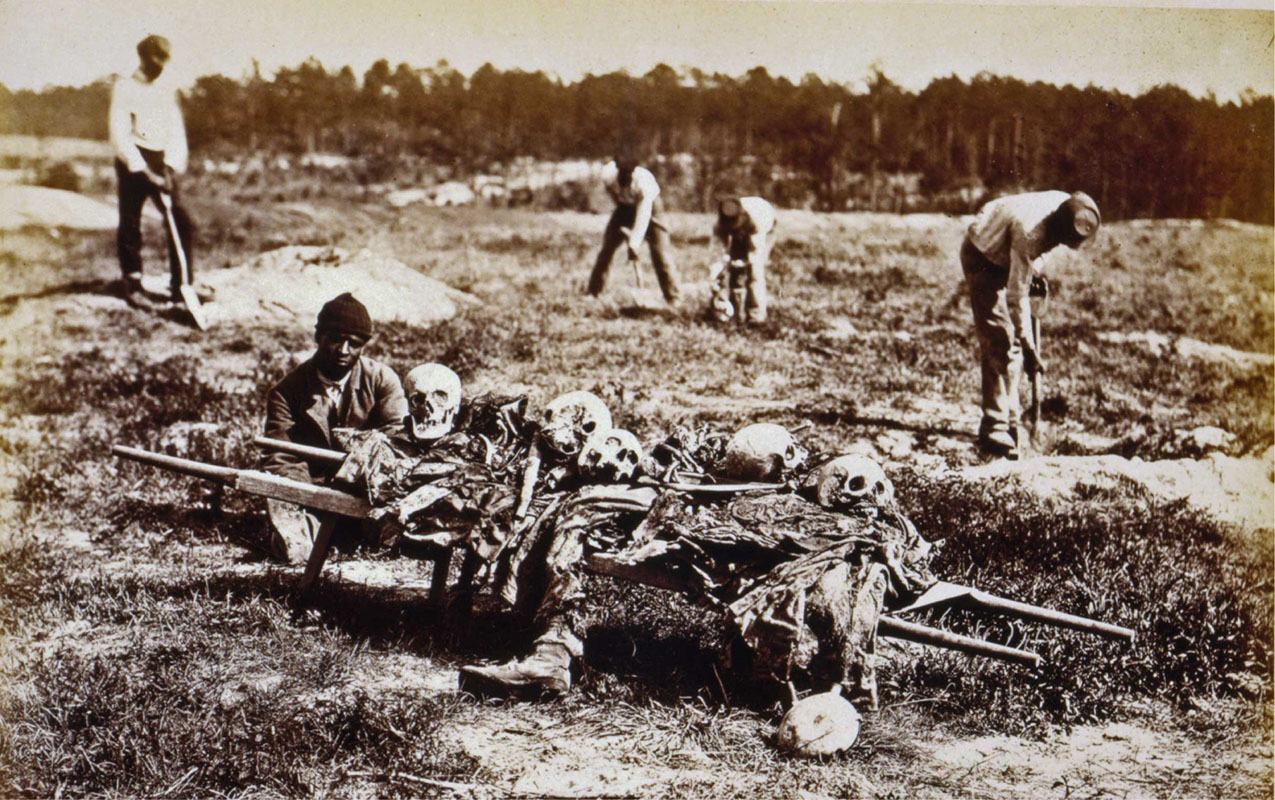 Image from Chapter 15 of U.S. History (opens in new window) from OpenStax, licensed under Creative Commons Attribution License v4.0 with the image information: This photograph by John Reekie, entitled, “A burial party on the battle-field of Cold Harbor,” drives home the brutality and devastation wrought by the Civil War. Here, in April 1865, African Americans collect the bones of soldiers killed in Virginia during General Ulysses S. Grant’s Wilderness Campaign of May–June 1864.Last week you learned about the many factors that led the nation right to the precipice of the Civil War. This final module will explore all aspects of the American Civil War including secession and the creation of the Confederate States of America, mobilization for war on both sides, major leaders, battles, and strategies during the war, its eventual end and the reasons for Union victory. Students will gain an appreciation of just how pivotal the Civil War was in American History--a war the nation seemed destined to fight from the beginning due to fundamental differences between north and south and one, in many ways, that is still being fought today as the nation continues to struggle with matters of race.Upon completion of this module, you will be able to:
Image from Chapter 15 of U.S. History (opens in new window) from OpenStax, licensed under Creative Commons Attribution License v4.0 with the image information: This photograph by John Reekie, entitled, “A burial party on the battle-field of Cold Harbor,” drives home the brutality and devastation wrought by the Civil War. Here, in April 1865, African Americans collect the bones of soldiers killed in Virginia during General Ulysses S. Grant’s Wilderness Campaign of May–June 1864.Last week you learned about the many factors that led the nation right to the precipice of the Civil War. This final module will explore all aspects of the American Civil War including secession and the creation of the Confederate States of America, mobilization for war on both sides, major leaders, battles, and strategies during the war, its eventual end and the reasons for Union victory. Students will gain an appreciation of just how pivotal the Civil War was in American History--a war the nation seemed destined to fight from the beginning due to fundamental differences between north and south and one, in many ways, that is still being fought today as the nation continues to struggle with matters of race.Upon completion of this module, you will be able to:- Demonstrate knowledge of the Secession Crisis and the creation of the Confederate States of America. (CO 1 and 2)
- Identify some of the strengths and weaknesses of the Confederacy and/or Union and the significance of some of the early developments/events/battles of the Civil War. (CO 1 and 2)
- Recognize the concept of “total war,” some of the most important efforts of mobilization, and the reason why 1863 was a pivotal year in the war. (CO 1 and 2)
- Recall facts about Lincoln's reelection in 1864 and the final years and ultimate victory of the Union in the Civil War. (CO 1 and 2)
To achieve these objectives:
- Read the Module 15 Introduction above.
- Read and view the materials in the Chapter 15 Pressbooks book below.
- View Chapter 15 PowerPoint below.
- Complete Module 15 quizzes/assignments/discussion boards based on chapter reading and PowerPoint.
Module Pressbooks Resources and Activities
You will find the following resources and activities in this module at the Pressbooks website. Click on the links below to access or complete each item.
-
In this module you will take your final exam. Read the instructions carefully and take note of any special submission guidelines.
TO REVIEW TEAM: A Final Exam has not been uploaded at this point. One will be created over the summer if deemed necessary by the review team.
Upon completion of this module, you will have:
- Read and viewed the final exam instructions
- Scheduled your exam with the proctoring service (If necessary)
- Prepared for and submitted your final exam
To achieve these objectives:
- Read and view the contents of "Exam Information and Instructions"
- Log in to the proctoring service (if necessary) and take your exam.
